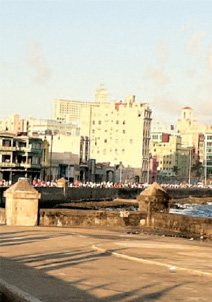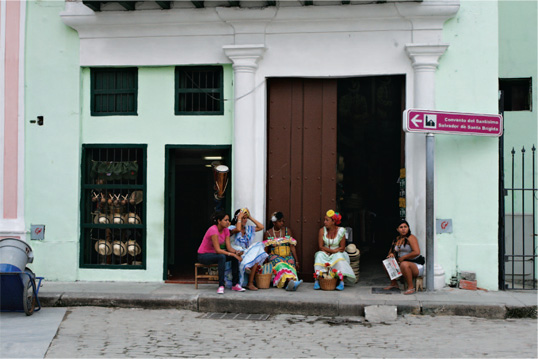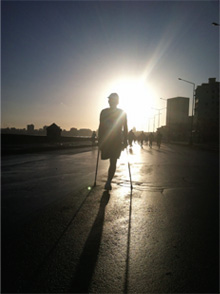
The moment I penciled the Havana Marathon in my race calendar, I felt a spark of excitement. I was going to Cuba! As word of my upcoming trip spread among my friends, the questions started streaming in: Are you scared? Is that legal? Are you sure you want to post that on Facebook? While the buzz surrounding the race ramped up my eagerness, the real reason I wanted to go to Cuba was more personal than political. Growing up, I knew I had Cuban branches on my family tree, but it wasn’t until I discussed the trip with my mother that I started to feel my roots hit soil.
My mother told me that her grandfather had grown up in the seaside city of Cienfuegos. Although he rarely spoke of his home country, his cultural background shone through in other ways. She remembered him directing family musicals with costumes handsewn by my great-grandmother, and that he kept a cigar in his mouth while he watched the children do their homework. I couldn’t help but wonder if I’d find a piece of his presence when I ran on Cuban soil for the first time.
Running Down Borders
Fostering a connection to my Cuban heritage might have been impossible if not for the work of one runner with a dream. The United States’ relationship with her sister to the south is notoriously tenuous. After President Bill Clinton eased travel regulations in 2000, a longtime lover of the country, Tom Popper, founded Insight Cuba, a program that allows Americans to connect with the Cuban community. In three short years, Insight became the most successful provider of Cuban travel—until another policy change in 2003 abruptly slammed shut the gates to Havana. But that didn’t stop Popper from dreaming: “While I was down there, I watched the Marabana [the Havana Marathon] and had the vision of Americans running side-by-side with Cubans in the race. When President Obama changed the travel policy in 2011, I created the first Insight Cuba trip for marathoners.” This year, 21 runners from the U.S., including myself, would toe the line at the race and put Popper’s vision into action. In 2012, he hopes to see 1,000 Americans participate in the event.
Racing Through Time
The flight from Miami to Cuba is a mere 42 minutes, but preparing for the trip felt more like packing for a time-traveling expedition than a weekend away. What many of us take for granted as modern-day conveniences simply don’t exist in Cuba. Credit cards aren’t accepted, American cell phones don’t work and Internet connections are slower than dial-up. I would soon discover that what Cuba lacks in technology, it more than makes up for with a richly vibrant culture.
As my plane descended on Havana,I noticed specks of orange, yellow and blue from the window. As the dots came into focus, I realized these were brightly colored classic cars that gave the city an aura of a retro movie set. I soaked in the views as I headed for the bus to join the rest of the American running team.
 Cuban Connection
Cuban Connection
Minutes after meeting the Insight Cuba team, I felt as though I was already among friends. While some were in Havana to cross Cuba off their marathon bucket list, many runners had come to rediscover their ancestry. The more we shared our personal stories, the more we found that there was a common thread of mystery surrounding our families’ Cuban heritage. Although many of our questions would remain unanswered, I found peace in sharing this connection with other runners.
That night, we enjoyed our first meal together on top of one of Old Havana’s tallest structures. Beautiful buildings popped up like tulips in the midst of crumbling architecture, soft lights reflected off cobblestone streets, and I began to fall in love with this breathtaking city.
Our team spent the next few days meeting with the Cuban community. While the typical destination marathon is filled with sightseeing, this trip was a unique opportunity to connect with the country’s people. We toured the Institute of Friendship, where we discussed Cuba’s healthcare and education system; the Sports University, where the country’s physical education teachers are trained; and the Sports Medicine Institute, where Olympic athletes prepare for competition. I was amazed at the warm reception we received at every meeting as well as Cubans’ innovative spirit to do more with less.
Running Together
The morning before the Havana Marathon,the city hosts the Maracuba, an event that leads crowds on three-kilometer run/walks that take place simultaneously throughout different municipalities. The non-competitive race promotes health, peace, friendship and solidarity. What started as a run quickly turned into a block party with kids running through the streets, people dancing on the sidewalks and music blasting at the finish line.There is joy for life in Havana that captures your soul, and I could feel myself being pulled along with the energy of the crowd and the rhythm of the music. A stranger looking on might have thought we were celebrating a fitness-themed family reunion. Although I never knew my great-grandfather, I felt as though I could sense his personality in the music and energy of the event.
For our pre-marathon dinner, we fueled up with traditional Cuban dishes. Normally, for me the night before a race is marked by careful planning and slight anxiety. As I dug into my pork and rice, however, I didn’t feel nervous at all. I wasn’t concerned about the predicted 85-degree temperatures or that I had never tried the local sports drinks that would be offered in plastic tubes along the course. Suddenly, none of my normal must-have race equipment (GPS watch, perfect music play-list, favorite gels) mattered. I simply wanted to run with less and make the most of my time on the course.

Marabana!
It was still dark outside as we headed to the start of the 25th annual Marabana Havana Marathon. Our team found a place in line with the other 2,600 runners, and I soaked in the sights as we waited for the gun. The local runners performed warm-up routines that looked more like a Zumba class than the sprints and leg swings you see at races in the U.S. Several children came up to ask for our shoes. Some American runners were well-prepared and had brought extra t-shirts to give out. I made friends with a local doctor who I promised to donate my shoes to at the finish line.
A few minutes later, we were off and running through cheering crowds that lined Havana’s streets. I couldn’t help but tear up. Mile after mile, American and Cuban runners were running side-by-side, moving forward together. We would all have to take the same steps to reach the finish.
Within a few kilometers, the race snaked onto the famous Malecón, a road lined by a seawall that stretches five miles along Havana’s coast. The sun was already rising, and it began to warm up. I kept hearing a metronome-like tapping sound behind me, but every time I turned around, the sun would block my view.
Soon a local runner passed me, smiling ear to ear. He was moving gracefully down the road supported only by crutches and one leg. I pulled along side him to chat in my broken Spanish, and we were able to make a few exchanges. (Me llamo es Jenny). As he carried forward, I was filled with gratitude for all of the finish lines that I am lucky enough to reach. Alexander Garcia will be with me whenever I need a reminder that running is a gift never to be taken for granted.
Reaching the Line
During the final miles of the Marabana, I thought about my great-grandfather. Although I will likely never know the details of his past, I felt his spirit as I ran toward the finish. The songs my grandmother (his daughter) played for us as children, suddenly made sense—it was the same music wafting through the air, carrying me to the line. As I crossed the finish, I felt profoundly settled in my soul. Every race is an opportunity to evolve, and this one taught me to tune in, look up and connect with the wonderful world around me.
[Source: Women’s Running Magazine – WomensRunning.com ]


